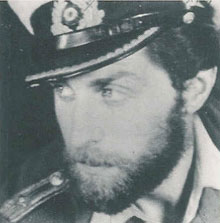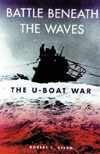24 August 1943: The Sinking of U-185
by Marc-André Haldimann
Foreword and Acknowledgements
The sinking of U-185 is not an unknown event: it is already narrated in some detail and with small discrepancies by two authors; though researched, their work includes at best only one of the 26 combat pictures taken during this action(1). This is definitely a drawback for the researcher as photographs are a precious primary source and, most importantly, serve to preserve a living memory of the life-and-death battles fought on the oceans more than half a century ago. To reestablish a link between written accounts and important photographic evidence in order to offer a clear understanding of those primary sources is the scope of the present research.
Piecing together a story almost 60 years old is no easy task. This study could not exist without the interest of Guðmundur Helgason, Administrator of the uboat.net site, and the help from other dedicated persons who were instrumental in unearthing the known facts about U-185. I am specially indebted and most thankful for the kindness and support shown by Jerry Mason, Administrator of the Uboatarchive.net site. Besides generously giving me his authorization for using the 1943 reports and the pictures published on his site, Jerry sent me other pictures hitherto unpublished. Many thanks also to KPP and Antonio Veiga who gave me through the uboat.net discussion forum the all-important link for Jerry Mason's first-rate site. Antonio Veiga also provided additional information and the link for the pictures of U-604 under attack. Don Balson provided the link for Markus Hoffmann's site which contains Kptlt Maus's account of the sinking. Last but not least, a special thought for my father, Frederic Haldimann, who kindly provided meteorological information for the sinking area on 24 August, 1943 (27.00 N, 36.07 W).
It is the author's belief that presenting the known facts and pictures is also a way to pay a tribute to all the men who lost their lives during the war at sea, be they Ubootmänner, air crews, civilian or military sailors from all nations involved.
A Troubled Trip Home
Commissioned on 13 June, 1942, U-185 was until its demise on 24 August, 1943 under the command of Kptlt August Maus. This Type IXC/40 U-boat was on its way home from its third patrol, by far the most successful: between 7 July and 6 August, Kptlt Maus and his crew sank 5 ships totaling 36,781 tons and damaged another of 6,840 tons(2).
The chain of events leading to the sinking of U-185 started soon after the beginning of the return trip from off the coast of Brazil. U-185 was patrolling in the same area as U-604 (Kptlt Horst Höltring) whose luck ran out at an early stage: having crossed the Equator on 22 July, the boat was attacked at 17.10 on 30 July off Sao Salvador (Brazil) by a PV-1 Ventura from VB-129(3). Killing two crew members on watch duty and wounding Höltring, this attack inflicted heavy damage, knocking out the port diesel and the Junkers air compressor, jamming the starboard hydroplane and puncturing several diving and fuel tanks(4). The amount of damage sustained made U-604 only marginally able to dive and made a safe return to its French base questionable.

30 July 1943, how the fateful chain of events began: U-604 awash after being strafed and bombed by a PV-1 Ventura of VB-129 piloted by Lt-Cdr T. D. Davis on July 30th 1943(a). This attack grievously wounded IWO Franz Aschmann and Bootsmaat Herbert Lurz; both men died the following day. Kptlt Höltring was also severely wounded in the chest and left shoulder(b). (NARA, 80 G ?, courtesy of Antonio Veiga).
A second air attack occurred at 10.25 on 3 August: a PBY-4 from VB-107 straddled U-604 with 6 bombs while it was awkwardly diving, but without inflicting further damage. When she broke surface again in the evening, U-604 was engaged by destroyer USS Moffett (DD 362) which hounded her for the next 20 hours, inflicting additional damage. By then it was obvious the stricken U-boat would never make it back and BdU ordered U-172 (Kptlt Emmermann) and U-185 to meet U-604 in order to take on her crew after her scuttling(5).
After failed meeting attempts due to constant airborne patrols, U-185 and U-604 finally met in the morning of 11 August, the crew of the latter starting at once the transfer of remaining provisions, oil and spare parts to U-185. After several hours of strenuous work, U-172 also arrived on the scene at 18.00. Detected by HF/DF localization, the meeting was crashed soon after by a Navy PBY-4 Liberator, piloted by the commanding officer of squadron VB-107, Lieutenant-Commander B. J. Prueher. Prueher took off with extra fuel tanks, knowing the targeted U-boats were on the edge of his plane's maximum range; after a 1,000-mile flight, he sighted the hoped-for U-boats. While U-604 lay helpless with most of her crew on the deck, and U-172 successfully crash-dived, the AA crew of U-185 opened fire on the Liberator which did two attack runs without inflicting damage, before being shot down out of control on the third, killing all aboard(6).
U-604 was scuttled soon afterward and Maus faced the daunting situation of crossing the Atlantic with 100 sailors aboard a U-boat designed to provide cramped "comfort" for only 54 people. On 16 August, after 5 days of navigation spent trying to get in contact with U-172, then arriving at a safe meeting point and waiting for U-Emmermann's arrival, Maus was finally able to transfer 23 members of U-604's crew to the latter boat. Those transferred were the lucky ones as events would prove.
Surprised in the Morning Sun
Running out of fuel, U-185 was directed by BdU to meet with U-847 north west of the Azores. On the 21st, his fuel supply being consumed at a fast pace, Maus called for a more southerly meeting point. His request was granted and thus he arrived at dawn on 24 August at the planned point only to be notified that U-847 would be two days late(7). Settling in the uneasy task of waiting for the belated Type IXD2 U-boat, U-185 was travelling surfaced northbound early in the morning of 24 August. The day was a fine one, wind was light, blowing east south east at 10/15 knots and despite a scattered to broken cloud cover of alto cumulus and cirrus, visibility was a good 15 kilometers. The known meteorological conditions certainly were a contributing factor in the demise of U-185, the lookouts having a difficult task surveying a sky littered with clouds. This gave a marked advantage to Lieutenants Robert P. Williams and Martin G. O'Neill, of VC-13, on their patrol.
Williams and his TBF-1 Avenger, also manned by radio operator M.C. Grinstead and gunner M. H. Paden, was launched from the deck of the escort carrier USS Core (CVE 13) at 06.07, together with the F4-F Wildcat of Lieutenant O'Neill and a second Avenger/Wildcat patrol piloted respectively by Lt. R. F. Neely and LCDR C. W. Brewer, Commanding Officer of VC-13. Their mission was to patrol ahead of the UGS-15 convoy and investigate the possible U-boat contacts located by HF/DF. At this stage of operations, the Hunter-Killer squadrons were implementing double patrols, each flown by an F4-F Wildcat fighter and an TBF Avenger bomber. The Wildcat had the task of suppressing the sometimes quite impressive AA artillery carried by U-boats; in the case of U-185, it comprised only one 20mm gun mounted on each of the two superimposed platforms of the new "Wintergarten" design. After the hoped-for suppression of AA fire, the slower TBF Avenger could do a good bomb run without taking excessive risks(8).
The O'Neill and Williams patrol was about 160 kilometers east of the Core, flying on a 090o heading, when Williams's radio operator caught a sun reflection shining on the fully surfaced U-185, The two planes used the welcome clouding to hide themselves; their sneak approach was a total success.
A few moments after 07.05, surprise was complete for the unfortunate lookouts of U-185 as, out of the sun, Lieutenant O'Neill bore down on them with guns blazing. The entire bridge watch was killed or wounded in this first pass which sealed the fate of U-185. Without leaving any time for the surprised crew to react, Williams led his Avenger in a steep attack run on the boat's starboard quarter. He almost spoiled his attack as he forgot to open the bomb bay doors; unfortunately for U-185, his radioman spotted the problem and ordered them to be opened on his own initiative, allowing two Mark 47 depth charges to drop from a height of 80 meters on the port side of the boat, which disappeared in a cloud of spray. The first D/C went off under the conning tower, the second next to the 10.5cm gun on the deck. When seen again, U-185 had turned almost 90 degrees to port with black smoke trailing from aft the conning tower. She was then seen listing to port and settling by the stern(9).
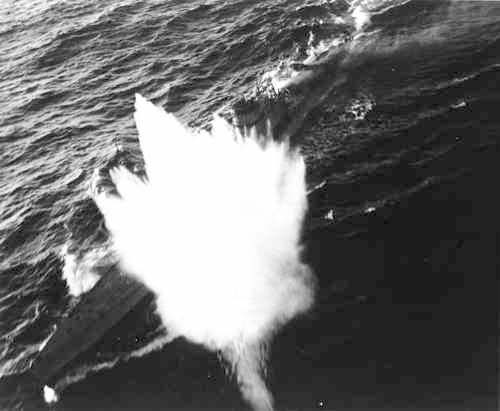
24 August 1943, shortly after 07.05: Lt. William's attack. U-185, after being strafed by Lt. O'Neill, is still travelling at 10–12 knots on a 330º heading as Lt. Williams' D/Cs splash on her port side. No one can be seen in the conning tower as both 20mm guns, unmanned, are pointed towards the sky. The U-boat already trails the "dense black low-lying smoke" noted by Lt. Williams in his report, whose cause at this stage remains unclear (revving-up diesels exhaust plume?) (NARA, no. 80 G 77197, published on the net by J. Mason).
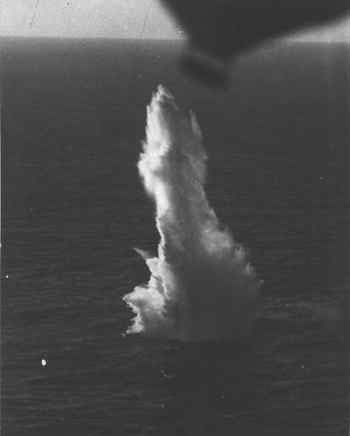
The instant of devastation. The full force of Lt. Williams' two exploding D/Cs engulfs U-185 almost completely. Only some 10 meters of the bow protrude from explosion plumes. (NARA, no.80 G 77195, courtesy of J. Mason).
The End
As Kptlt Maus relates, the devastation aboard U-185 was terrible. Hearing gunfire and the detonation of the two D/Cs, Maus scrambled onto the conning tower and saw all his watch crew dead or dying and the 10.5cm gun lying on the deck, knocked out of its pivot, but those were lesser issues compared to the pandemonium unfolding inside the boat. The depth charge detonations ruptured the port diving tanks and oil cells, the pressure hull and the battery cells under the officers mess, allowing sea water to reach them and immediately produce deadly chlorine fumes. Both diesels were running now at flank speed, but the shock wave provoked the simultaneous failure of both engine oil pumps, already worn out; the left diesel seized soon afterwards and caught fire, spreading noxious fumes which overcame and finally killed all the engineers on watch. This already desperate situation was worsened by the disabling of all electrical systems, darkening the boat and impeding all internal communications as Maus's Leitender Ingenieur (LI) Robert Ackermann reported on the situation by shouting to his commanding officer(10).
As U-185 developed a heavy port list, had its aft bridge almost totally underwater, suffered an unconfined engine fire and was permeated by chlorine, Maus realized the situation was hopeless and ordered through voice relay all hands to don their life vests and abandon ship. Unknown to him, a drama was unfolding in the forward torpedo compartment: a wounded sailor of U-185, lying on his cot and unable to move without assistance, was begging Kptlt Höltring, himself partly disabled by his wounds, to kill him with his ordnance pistol rather than let him drown. This he did before turning his weapon against himself and committing suicide(11).
More then 40 men managed to leave the blazing and highly toxic interior of U-185, huddling on the "Wintergarten" platforms. Their relief was short lived as the boat was now rapidly sinking by the stern though amazingly maintaining a speed of 9 knots for some minutes, thanks to the still running diesel. At about this time, the second Wildcat/Avenger patrol flown by LDCR Brewer and Lt. Neely reached the scene. Brewer strafed the already doomed submarine twice, wreaking havoc among the U-boat crew huddled on the "Wintergarten". Lt. Neely then lined up his Avenger for a bombing run he had to abort owing to a faulty circuit breaker preventing the release of his ordnance.
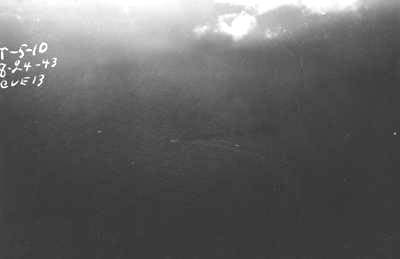
The wounds. Now deprived of D/Cs and waiting for the arrival of LCDR Brewer and Lt. Neely's patrol, Lt. Williams circles the combat scene while his radio operator, M.C. Grinstead, takes pictures of U-185 as it still has forward speed but trails a dense black smoke plume caused by the seized and burning left diesel engine. The oil slick marking the path of U-185 is a telltale sign of ruptured oil tanks. (NARA, no.80 G 87356, courtesy of J. Mason).
Another bombing run was abandoned: U-185's conning tower was almost totally engulfed by water as its bow angled towards the sky, while the surviving crew jumped from the rear AA platforms. Maus, sitting on the starboard conning tower casing, was the last one to be washed overboard as waves closed over his boat. The bow reached an angle of about 60 degrees before it slid under the surface, entombing over 30 men. Not all Ubootmänner in the water survived, though the air temperature was 24º Celsius and the water an even warmer 25º Celsius: an unknown number died from bullet wounds or chlorine poisoning while floating(12). 36 men alive were picked up later by destroyer USS Barker (DD 213), which arrived on the scene at 11.40.
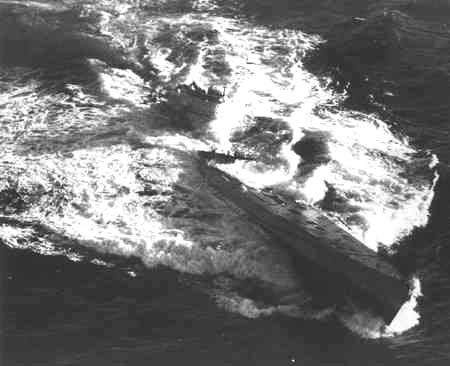
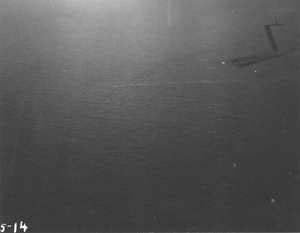
The last moments. U-185 is almost gone, only a few meters of the bow protrude and the conning tower's position is marked by the swirl in the water. The black smoke from the burning diesel hangs in the air and the oil slick is obvious. (NARA, no.80 G 87360, courtesy of J. Mason).
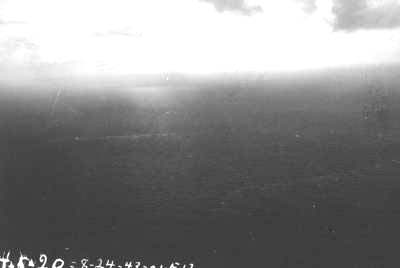
The aftermath. U-185 is now gone, but her last miles are clearly outlined by the oil slick she left after Lt. Williams' D/C straddle. Her original course can be seen on the lower center of the picture, and one can track the large left turn she made as she went down, bringing her on reverse course. Only 10 to 15 minutes elapsed between the first strafing and the sinking of U-185. This pictures also shows the prevailing meteorological conditions, particularly the scattered cumulus which hid O'Neill and Williams' approach (NARA, no.80 G 87366, courtesy of J. Mason).
Sadly, Marine Oberassistenzarzt Dr. Georg Bamler and Obermechanikermaat Rudolf Erdmann died on board the same day from their grievous wounds, as did Oberleutnant (Ing.) Herbert Ackermann, the LI of U-185, who succumbed to chlorine poisoning. Maschinenmaat Friedrich Anspach died also from chlorine inhalation the following day(13). The 25 other men from U-185 and the 9 survivors from U-604 all recovered and spent the following three years as POWs before returning to Germany.
Notes
1. William Y’Blood gives a clear account of this action, based on US Navy reports in his excellent book. His sources are well understood and only slight inaccuracies can be found (Y’Blood 1983). Robert C. Stern gives another insight on this combat by telling the story more from a German point of view. His laudable approach seems to be marred by some of the sources he uses, especially the unofficial drafts of the interrogation report of U-185’s crew. A close study of the official interrogation report of U-185’s crew matched with a postwar account of the sinking given by Kptlt Maus do reveal severe discrepancies for this combat (Final Report 1943/Stern 1999). As for the full series of combat photographs, they are stored at the National Archives, at College Park, Maryland and bear the following numbers: 80 G 77195 – 77198; 80 G 87344 – 87348: 80 G 87351 – 87367 (indications by courtesy of J. Mason). The only widely known one is picture 5, NARA 80 G 77196, often published with spurious or incomplete legends in general books on the U-boat war.
2. http://uboat.net/boats/u185.htm.3. Stern (1999), 140.
4. Final Report (1943), 25 – 26.
5. Final Report (1943), 27 – 28 ; Stern (1999), 140 – 141.
6. Final Report (1943), 5 – 6 ; Franks et Zimmerman (1998), 142 –143.
7. Stern (1999), 143.
8. Y’Blood (1983),
9. ASW-6 (1943); Y’Blood (1983), 92.
10. http://gofurther.de/bdu/uboote/dieboote/u0185.html
11. Final Report (1943), 8.
12. Final Report (1943), 9.
13. http://gofurther.de/bdu/uboote/dieboote/u0185.html
a. Franks et Zimmerman (1998), 142.
b. Final Report (1943), 25 – 26.
Sources:
ASW-6 (1943): Antisubmarine action by aircraft Report (ASW-6) completed after Lt. Williams' flight, NARA, College Park, Maryland. Published on http://www.uboatarchive.net, by J. Mason.
Final Report (1943): Final Report – G/Serial 26: Report on the interrogation of survivors from U-604 and U-185, sunk 11 August 1943 and 24 August, 1943, NARA, College Park, Maryland. Published on http://www.uboatarchive.net/U-185INT.htm, by J. Mason.
Franks N. and Zimmerman, E. (1998). U Boat versus Aircraft, Grub Street, London.
Stern, R. C. (1999). Battle beneath the Waves: The U-Boat War. Arms and Armour Press, London.
http://gofurther.de/bdu/uboote/dieboote/u0185.html: Markus Hoffman's site publishes Kptlt Maus' firsthand account on the sinking of U-185.
http://www.navylib.com/U604.htm: Jim Augustus' site publishes the picture of U-604 attacked by a Ventura PV-1 of VB-129, on 30 July, 1943.
http://www.uboat.net/: Guðmundur Helgason's site gives all the essential background data available on U-185 as well as a short biography of Kptlt August Maus.
http://www.uboatarchive.net - Jerry Mason's fundamental site publishes the primary sources including a wealth of pictures available on U-185, preserved by the National Archives at College Park, Maryland.
Y'Blood, W. T. (1983). Hunter-Killer: U.S. Escort Carriers in the Battle of the Atlantic, Naval Institute Press, Maryland.
15 March 2001
Marc-André Haldimann
Appendix A: The Crew of U-185 as Listed in Final Report (1943), p. 65 – 66.
Name Rank Age
Officers
Maus, August Kapitänleutnant 28
Rieve, Hans Otto Leutnant z. S. 22
Loos, Leutnant z. S.
* Ackermann, Herbert Oberleutnant (Ing.)
* Rammler, Oberassistenzarzt
Men
Oppermann, Kurt Obersteuermann 23
* Rehbaum, I Obermaschinist
* Bienfield, Iher II Obermaschinist
Jablonsky, Wilhelm Oberbootsmannsmaat 28
Düppengiesser, Karl Bootsmannsmaat 23
Willmann, Georg Bootsmannsmaat 28
* Bücher, Oberfunkmaat
Ahlers, Karl Heinz Funkmaat 25
* Wismeyer, Jupp Maschinenmaat
Haupmann, Gehard Maschinenmaat 23
Hussner, Richard Maschinenmaat 23
Schmiga, Konrad Maschinenmaat 24
* Scherer, Jakob Maschinenmaat
Fleischmann, Leo Maschinenmaat 24
Ansbach, Friedrich Maschinenmaat
* Bachfischer, Alois Maschinenobergefreiter
Pietzke, Maschinenobergefreiter
Schöbb, Ernst Maschinenobergefreiter
Wispereit, Freidrich Maschinenobergefreiter
* Erdmann, Rudolf Mechanikermaat (T)
* Neubauer, Paul Matrosenobergefreiter
Glosemeyer, Franz Matrosenobergefreiter
Schenk, Heinrich Matrosenobergefreiter
* Willnat, Heinz Matrosenobergefreiter
* Rotterdam, Heinz Matrosenobergefreiter
Schmeiss, Edmund Matrosenobergefreiter
Rohde, Bernhard Matrosenobergefreiter
* Scholz, Heinz Matrosenobergefreiter
Schmitz, Wilhelm Matrosenobergefreiter
* Bürschneider, Christoph Mechanikerobergefreiter
* Banecke, Heinz Mechanikerobergefreiter
* Beidat, Funkobergefreiter
* Hagar, Emil Funkgefreiter
* Steinbach, Maschinengefreiter
Hodam, Erwin Maschinenobergefreiter
* Stockmann, Rudi Maschinenobergefreiter
Kopatz, Erich Maschinengefreiter
* Pluskota, Mechanikergefreiter
* Voss, Walter Matrosengefreiter
* Peter, Otto Matrosengefreiter
Randenrath, Paul Matrosengefreiter
* Walter, Herbert Matrosengefreiter
* Skots, Walter (cook) Matrosengefreiter
* Casualty
Appendix B: The Crew of U-604 as Listed in Final Report (1943), p. 29 – 30. Name Rank Age
Officers
* Höltring, Horst Kapitänleutnant 29
* Aschmann Frank Oberleutnant z. S.
v. Bothmer, Herman Leutnant z. S. 31
** Jürgens, Helmut Oberleutnant (Ing.)
** Kühn, Oberleutnant
Men
** Finster, Albert Obersteuermann
** Schiffer, Obermaschinist
* Beugholz, Obermaschinist
* Altmann, Helmut Oberbootsmaat
** Binnefeld, Peter Bootsmaat
* Lurz, Herbert Bootsmaat
* Schnede, Ernst Mechanikermaat
* Helsper, Obermaschinenmaat
Wagenfuhr, Friedrich Maschinenmaat 23
Winter, Ernst Maschinenmaat 25
** Ortwein, Maschinenmaat
** Marquard, Robert Maschinenmaat
** Fröde, Fred Maschinenmaat
** Seitz, Georg Funkmaat
* Keller, Horst Funkmaat
** Reiblich, Mechanikerrobergefreiter
Nieswand, Walter Mechanikerrobergefreiter 20
* Opitz, Richard Matrosenobergefreiter
* Schultz, Werner Matrosenobergefreiter
* Bibo, Ferdinand (cook) Matrosenobergefreiter
** Gebauer, Horst Matrosenobergefreiter
Trommer, Heinz Maschinenobergefreiter 19
Ehlert, Horst Maschinenobergefreiter
* Rotner, Rudolf Maschinenobergefreiter
* Straunch, Karl Maschinenobergefreiter
** Seipel, Peter Maschinenobergefreiter
** Werner, Ernst Maschinenobergefreiter
** Klawin, Erwin Maschinenobergefreiter
** Müller, Heinz Funkobergefreiter
* Lux, Walter Funkgefreiter
* Lüttges, Heinz Maschinengefreiter 19
** Anschutz, Mechanikergefreiter
* Bellmann, Paul Mechanikergefreiter
Eismann, Werner Matrosengefreiter 19
** Beher, Werner Matrosengefreiter
* Schnitte, Matrosengefreiter
** Rokowski, Matrosengefreiter
** Alrutz, Gunther Matrosengefreiter
** Shreckerbach, Maschinengefreiter
** Schroter, Maschinengefreiter
** Schumacher, Maschinengefreiter
** Krimmling, Gerhard Maschinengefreiter 19
** Beck, Heinz Maschinengefreiter
* Casualty
** Transferred to U-172
This article was published on 10 Jun 2001.
Buy this title at amazon.com See more sellers |
Books dealing with this subject include
|
